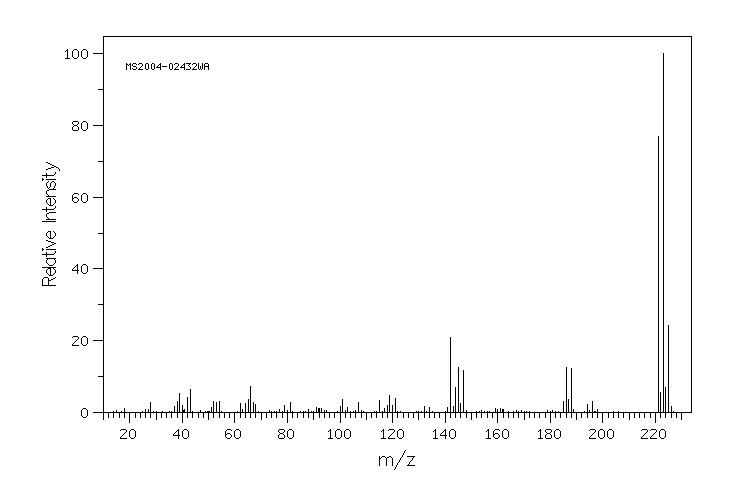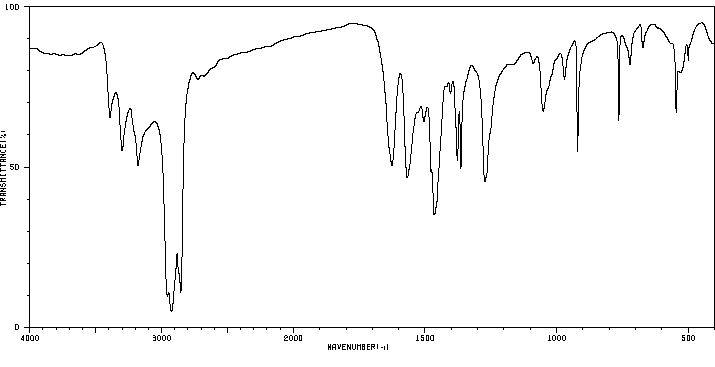5-溴-2-氯-6-甲基嘧啶-4-胺 | 54093-23-1
中文名称
5-溴-2-氯-6-甲基嘧啶-4-胺
中文别名
——
英文名称
4-amino-5-bromo-2-chloro-6-methylpyrimidine
英文别名
5-bromo-2-chloro-6-methylpyrimidin-4-amine;5-bromo-2-chloro-6-methyl-pyrimidin-4-ylamine;5-Brom-2-chlor-6-methyl-pyrimidin-4-ylamin
CAS
54093-23-1
化学式
C5H5BrClN3
mdl
——
分子量
222.472
InChiKey
RROWXSDPROYXCJ-UHFFFAOYSA-N
BEILSTEIN
——
EINECS
——
-
物化性质
-
计算性质
-
ADMET
-
安全信息
-
SDS
-
制备方法与用途
-
上下游信息
-
文献信息
-
表征谱图
-
同类化合物
-
相关功能分类
-
相关结构分类
计算性质
-
辛醇/水分配系数(LogP):1.9
-
重原子数:10
-
可旋转键数:0
-
环数:1.0
-
sp3杂化的碳原子比例:0.2
-
拓扑面积:51.8
-
氢给体数:1
-
氢受体数:3
安全信息
-
海关编码:2933599090
SDS
上下游信息
-
上游原料
中文名称 英文名称 CAS号 化学式 分子量 2-氯-4-氨基-6-甲基嘧啶 2-chloro-6-methyl-pyrimidin-4-ylamine 14394-60-6 C5H6ClN3 143.576
反应信息
-
作为反应物:描述:5-溴-2-氯-6-甲基嘧啶-4-胺 在 sodium amide 作用下, 以 乙醇 、 N,N-二甲基甲酰胺 为溶剂, 反应 5.0h, 生成 7-methyl-N-phenyl-5-pyrrolidin-1-yl[1,3]thiazolo[4,5-d]pyrimidin-2-amine参考文献:名称:噻唑并[4,5- d ]嘧啶衍生物的新途径摘要:通过用乙醇氨和仲胺顺序处理,可以从新制备的5-溴-2,4-二氯-6-甲基嘧啶中容易地获得4-氨基-5-溴-2-取代的氨基嘧啶。这些化合物成功地与各种异硫氰酸酯在DMF中的磺酰胺存在下反应,形成新的噻唑并[4,5- d ]嘧啶衍生物。DOI:10.1002/jhet.5570430527
-
作为产物:描述:参考文献:名称:噻唑并[4,5- d ]嘧啶衍生物的新途径摘要:通过用乙醇氨和仲胺顺序处理,可以从新制备的5-溴-2,4-二氯-6-甲基嘧啶中容易地获得4-氨基-5-溴-2-取代的氨基嘧啶。这些化合物成功地与各种异硫氰酸酯在DMF中的磺酰胺存在下反应,形成新的噻唑并[4,5- d ]嘧啶衍生物。DOI:10.1002/jhet.5570430527
文献信息
-
[EN] AMINOPYRIDINE DERIVATIVES AS PHOSPHATIDYLINOSITOL PHOSPHATE KINASE INHIBITORS<br/>[FR] DÉRIVÉS D'AMINOPYRIDINE UTILISÉS EN TANT QU'INHIBITEURS DE LA PHOSPHATIDYLINOSITOL PHOSPHATE KINASE申请人:PETRA PHARMA CORP公开号:WO2019126731A1公开(公告)日:2019-06-27The invention relates to inhibitors of PI5P4K inhibitors useful in the treatment of cancers, neurodegenerative diseases, inflammatory disorders, and metabolic diseases, having the Formula: (I) where A, B, R1, X1, X2, and W are described herein.
-
[EN] POLYCYCLIC COMPOUNDS AS ALLOSTERIC SHP2 INHIBITORS<br/>[FR] COMPOSÉS POLYCYCLIQUES UTILISÉS EN TANT QU'INHIBITEURS ALLOSTÉRIQUES DE SHP2申请人:REVOLUTION MEDICINES INC公开号:WO2019118909A1公开(公告)日:2019-06-20The present disclosure is directed to inhibitors of SHP2 and their use in the treatment of disease. Also disclosed are pharmaceutical compositions comprising the same.本公开涉及SHP2的抑制剂及其在治疗疾病中的应用。还公开了包含相同成分的药物组合物。
-
Fe(III) and cobalt(II) coordination compounds of 5-bromo-6-methyl-2-morpholinepyrimidinium-4-amine pyridine-2,6-dicarboxylate作者:Hossein Eshtiagh-Hosseini、Zakieh Yousefi、Maryam Shafiee、Masoud MirzaeiDOI:10.1080/00958972.2010.508284日期:2010.9.20octahedral geometries. Compound 1 is an anionic mononuclear complex and 5 is a binuclear compound constructed from cationic and anionic parts. The crystal data of 5 reveal that the cationic part is formed by five terminal waters and one μ-carboxylate oxygen O2 from the anionic portion and the anionic complex is built from two deprotonated (pydc)2− moieties. In the compounds, pydcH2 is tridentate by新配位化合物,(bmmpaH)[Fe(pydc)2] · (EtOH)0.8(H2O)0.2 (1), (8QH)[Fe(pydc)2] · (2), (2ampyH)2[Mn( pydc)2] · (3), (2ampyH)[Cr(pydc)2](2ampy)0.5 · (4), [Co( )5-μ-(pydc)Co(pydc)] · 2 ( 5), [Ni(pydcH)2] · (6), 和 [Cu(pydcH)2] (7), 其中 bmmpa, 8Q, 2ampy, pydcH2 是 5-bromo-6-methyl-2-morpholinepyrimidine-4胺、8-羟基喹啉、2-氨基-6-甲基吡啶和吡啶-2,6-二羧酸分别已合成,并通过元素分析、红外、紫外光谱方法和 X 射线晶体学进行结构表征。1 和 5 的金属离子是六配位的,具有扭
-
Thiazolo[4,5-d]pyrimidines: synthesis and antibacterial evaluation作者:Mohammad Rahimizadeh、Mehdi Bakavoli、Ali Shiri、Reyhaneh Faridnia、Parvaneh Pordeli、Fatemeh OroojalianDOI:10.1515/hc.2011.016日期:2011.1.1Abstract The reaction of 4-amino-5-bromo-2-chloro-6-methylpyrimidine (1) with carbon disulfide in the presence of KOH in DMF quantitatively gave 5-chloro-7-methylthiazolo[4,5-d] pyrimidine-2 (3H)-thione (2) which was then alkylated at the sulfur atom with various alkyl halides in the presence of Et3N in acetonitrile to give alkylthio derivatives 3. The substitution of the chlorine atom in 3 with morpholine
-
NITROGEN-CONTAINING FUSED HETEROCYCLIC SHP2 INHIBITOR COMPOUND, PREPARATION METHOD, AND USE申请人:SHANGHAI RINGENE BIOPHARMA CO., LTD.公开号:US20220127271A1公开(公告)日:2022-04-28Disclosed are a nitrogen-containing fused heterocyclic SHP2 inhibitor compound, a preparation method, and use. The nitrogen-containing fused heterocyclic SHP2 inhibitor compound is represented by formula I below. The compound has high inhibitory activity for an SHP2 enzyme and tumor cell proliferation, and has good druggability.
表征谱图
-
氢谱1HNMR
-
质谱MS
-
碳谱13CNMR
-
红外IR
-
拉曼Raman
-
峰位数据
-
峰位匹配
-
表征信息
同类化合物
(S)-3-(2-(二氟甲基)吡啶-4-基)-7-氟-3-(3-(嘧啶-5-基)苯基)-3H-异吲哚-1-胺
(6-羟基嘧啶-4-基)乙酸
(4,5-二甲氧基-1,2,3,6-四氢哒嗪)
鲁匹替丁
马西替坦杂质7
马西替坦杂质4
马西替坦杂质
马西替坦原料药杂质D
马西替坦原料药杂质B
马西替坦
顺式-4-{[5-溴-2-(2,5-二甲基-1H-吡咯-1-基)-6-甲基嘧啶-4-基]氨基}环己醇
非沙比妥
非巴氨酯
非尼啶醇
青鲜素钾盐
雷特格韦钾盐
雷特格韦相关化合物E(USP)
雷特格韦杂质8
雷特格韦EP杂质H
雷特格韦-RT9
雷特格韦
阿西莫司杂质3
阿西莫司
阿脲四水合物
阿脲一水合物
阿维霉素
阿米美啶
阿米洛利
阿米妥钠
阿洛巴比妥
阿普瑞西他滨
阿普比妥
阿巴卡韦相关化合物B(USP)
阿卡明
阿伐那非杂质V
阿伐那非杂质1
阿伐那非杂质
阿伐那非中间体
阿伐那非
铂(2+)二氯化6-甲基-1,3-二{2-[(2-甲基丙基)硫烷基]乙基}嘧啶-2,4(1H,3H)-二酮(1:1)
钴1,2,3,6-四氢-2,6-二氧代嘧啶-4-羧酸酯(1:2)
钠5-烯丙基-4,6-二氧代-1,4,5,6-四氢-2-嘧啶醇酸酯
钠5-乙基-4,6-二氧代-1,4,5,6-四氢-2-嘧啶醇酸酯
钠5-(2-溴丙-2-烯基)-5-丁烷-2-基-4,6-二氧代-1H-嘧啶-2-醇
醌肟腙
酒石酸噻吩嘧啶
那可比妥
辛基2,6-二氧代-1,2,3,6-四氢-4-嘧啶羧酸酯
赛乐西帕杂质3
赛乐西帕KSM3








